Soutien - Unité - Entraide

Cours de Gestion Commerciale
S’il vous plaît, avant de commencer, vérifiez en bas de la page, cliquez par langue, choisissez une langue qui vous sera plus facile à étudier et à bien comprendre
Retail Management - Merchandising, Distribution and Marketing
Learn how to boost sales with merchandise displays, marketing and inventory planning in this free online retail course.
This course teaches you about essential but non-obvious facets of the retail industry, including marketing, merchandising and distribution. We show you techniques to rack up impressive sales in a retail environment, from savvy pricing that increases foot traffic to effective in-store marketing. Whether you run your own small business or work for a large company, this course in retail management can boost your sales skills and career.
What You Will Learn In This Free Course
- Define and describe ‘retail merchandising’
- Explain how visual merchandising can affect sales
- Outline the principles of design
- Indicate how to design an effective display
- Explain the channels of distribution
- Define and describe the ‘4 Ps’
- Discuss product mixes, lines and individual products
- Describe the ‘linear communication’ model
- Outline the four important characteristics of communication tools
- Explain the calculation for ‘open-to-buy’ planning
MODULE: 1
Upon completion of this module, you will be able to:
- Define and describe retail merchandising.
- Explain how visual merchandising can affect sales.
- List the principles of design.
- Explain how to design a good display.
- Explain the channels of distribution.
Pricing
Before merchandisers receive goods, they must first be in contact with the manufacturers. At this stage, merchandisers will decide what products to buy, negotiating a unit price, and arranging for delivery. If the retailer is purchasing a high number of units at a given time, they may easily be able to receive a discounted price. If they receive items at a lower price, they can sell them at a lower price and gain a competitive edge.
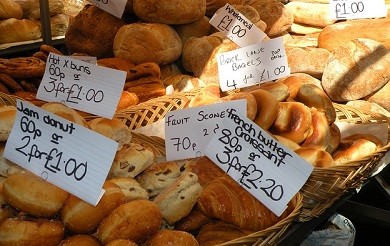
Some retailers follow a formula for setting their retail price while others will base retail prices on the desirability of the item or the competition from nearby retailers.
The method of determining price can often be described using one of three models:
- Cost-based pricing – this method considers the cost of the item and the cost of selling the item
- Competition-based pricing – this involves examining the prices set by the competition
- Customer-based pricing – prices are set according to product demand
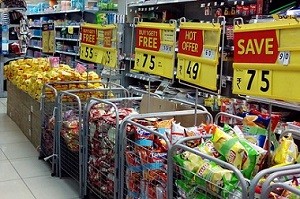
How to determine the price:
- Know the MSRP, or the manufacturer suggested retail price.
- Determine how much you want to profit from the original cost of the item. For example, if you want to make a 40% profit on an item priced at 3.00, the item needs to be sold at $4.20.
- Know what the competition is charging and try to find a medium between charging more than competitors or severely undercutting competitors, as both will cause the retailer to lose customers.

After the retail price has been set, the next step is setup and display. This means displaying goods so that they have the best opportunity to be noticed.
This could include display windows, platforms, or colorful backdrops. This visual aspect is often key to making the sale, particularly with fashion merchandise.
Visual Merchandising
One example of a tried and true layout is the Grid, or Straight, Design. This is best in retail environments when customers shop the entire store, such as a supermarket. The downside to this layout is that it is difficult to see over fixtures.
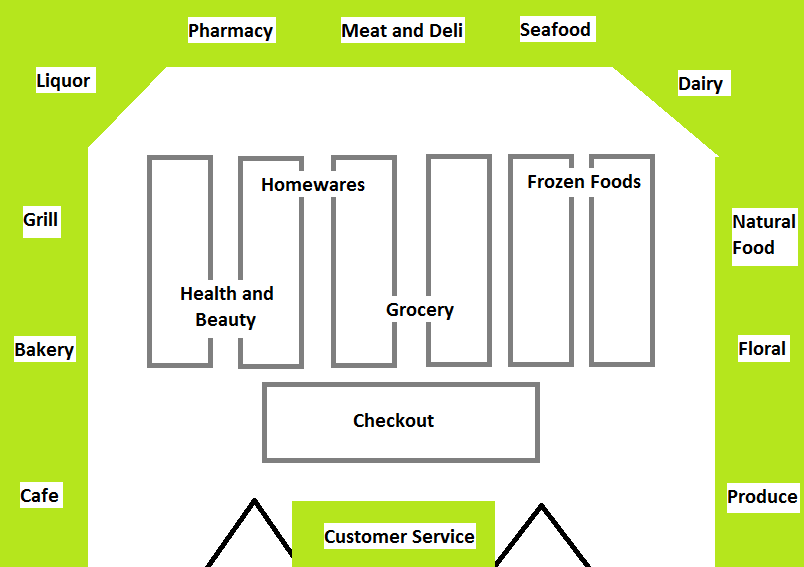
This works best in stores under 5000 square feet and is widely used by clothing stores.
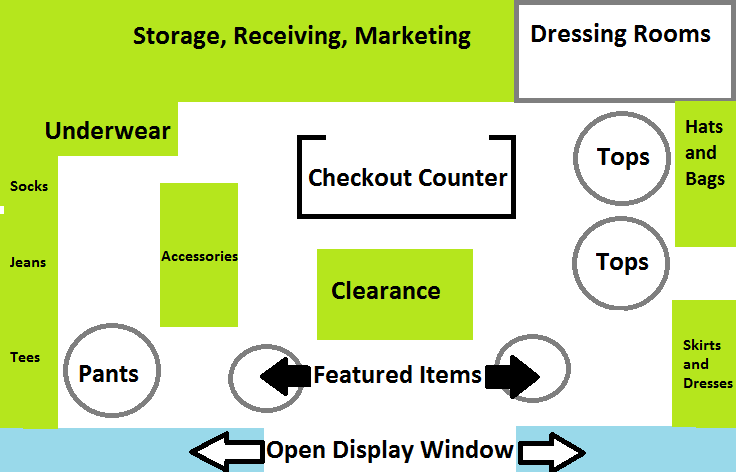
- Is the store easy to locate?
- Is the location clean, safe, and accessible?
- Are the signs clean and readable?
- Are the entrances obvious?
- Are the windows bright and inviting?
- Do window displays change often with season or style?

- A simple, well-designed sign will have an impact ad will convey a positive feeling to a customer.
- Signs that are unusual will stand out.
- A shabby sign with missing lights or peeling pate will convey the idea that a business is poorly managed.
- The sign is the stores signature – it should be immediately recognizable as belonging to a particular business.
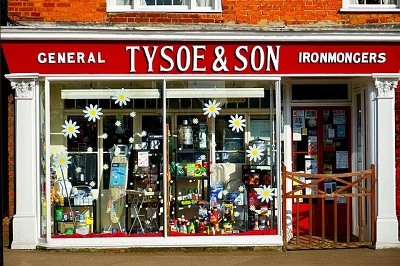
This can be see in the photo example:
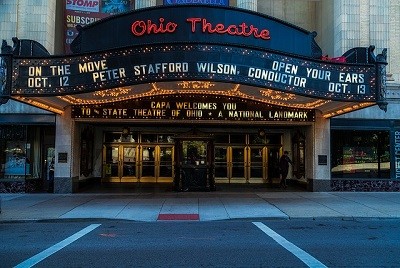
Banners should vary greatly from each other so that shoppers will continue to notice them as they change. If a banner is used throughout a store or throughout the promotional material, a customer’s identification of the business will improve.
An example of two banners can be seen below:
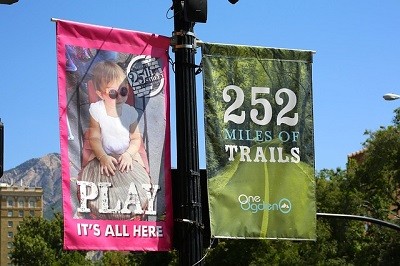
There are many varieties of awnings; some awnings are backlit to draw attention to a business at night.
The image is an example of an apartment building that has utilized an awning and plants to draw the eye.
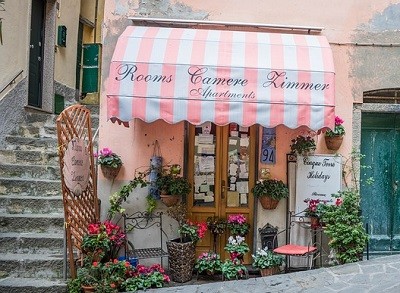
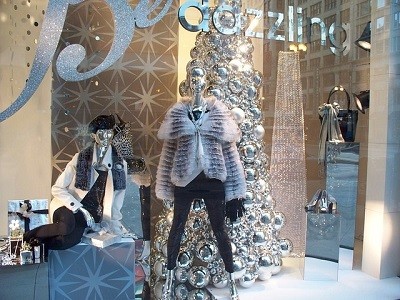
Some examples include:
- Goods displayed as they would be used.
- Media tie-ins, such as a newly released book.
- Animation, such as in many holiday displays.
When designing an interior display, retailers should ask:
- What is the store’s image? Maintain consistency.
- What types of customers shop at your store? Design your display to appeal to them.
- What is the concept? Make sure it is clear to the consumer and that messages are clear.
- Where is the display going to be set up? Make sure the design elements will work well with the location.
- Why is this particular merchandise being displayed? Do not display goods that you have few of; only display goods that have sufficient back stock.
Principles of Design
Symmetrical balance means that items are of equal size.
Asymmetrical balance presents two items that are of equal weight but are not the same size. For example, something large can be balanced by several small items.
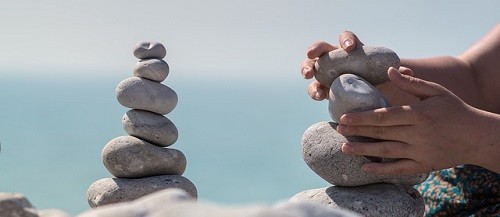

Emphasis is the point of initial eye contact and the formulation of a focal point. A display should emphasize a theme or mood. A theme or mood might reflect a season, celebration, or a store event.
Emphasis can be created in several ways, such as a single item surrounded by blank space, unusual textures, or reflective surfaces.
Proportion refers to the ratio of the parts to the whole. Items should appear consistent when placed next to each other.
Rhythm refers to the measurement of organized movement. In terms of visual displays, this means that the eye travels smoothly from one object to another.
There are three forms of harmony – functional, structural, and decorative.
- Functional harmony refers to how something works, so to achieve functional harmony, a display must be realistic.
- Structural harmony refers to items correctly fitting together. For example, it does not make sense to have home appliances on display with sports equipment.
- Decorative harmony refers to the aspects of a display that are not for sale but add to the atmosphere of the display. For example, hanging paper snowflakes would create decorative harmony with a display of winter sports equipment.
Warm colors, such as red, yellow, or orange, are stimulating, cheery, and intimate. They make a room feel smaller and objects seem larger.
Cool colors, such as blue, green, or violet, are relaxing. Rooms in cool colors look larger.
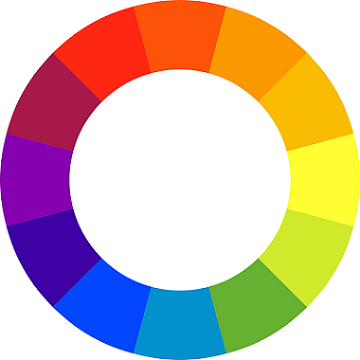

- Primary lighting refers to the overall illumination within the store.
- Accent lighting illuminates display areas. This can be done through ceiling lighting, showcase lighting, or valance lighting.
- Atmosphere lighting is used to create effects, such as colored lights, spotlights, or black lights.
Designing a Display
For example, a display selling women’s clothes might include mannequins holding handbags that are also for sale in the store. It should be pointed out that any merchandise in a display should have sufficient back stock, as people are inevitably going to be more interested.

There are some rules that should be followed when setting up fixtures include:
- Include at least 3 feet between racks.
- The most common aisle width is 6 feet.
- Well-planned aisles work best.
- Organize racks in aisles and place large fixtures, such as shelving units, along back walls.
- Although high priced items will have less stock, they should be places on stands that give the illusion of space, such as four-way stands.
- Create “exciting” displays of mass merchandise, arranging by color or style.

An example could be a display of rain coats with a sign stating, “It’s festival season! Stay dry with our rain coats.”
Some tips for using signs include:
- Maintain white space to avoid cluttering the sign and overwhelming the customer.
- Use key words such as money, save, easy, love, results, etc.
- Do not use a sign if you do not need to.
- Check daily that signs are not out of date or misplaced i.e. from old promotional events or for different merchandise.
- Print information on both sides of a sign so that customers can read it from either direction.
- Ensure that there is consistency in the color and style choices of the sign and that the sign is cohesive with your store image.
- Feature brand names whenever possible.
Too Much or Too Little Merchandise
Too much merchandise can look cluttered and confuse the shopper.
Too little merchandise will appear to shoppers as though the store cannot afford to restock. Furthermore, place items on displays that will suit the amount of stock you have. For example, do not place four shirts on a table intended to hold twenty shirts – this will make the display look empty and unappealing.
Lack of a Theme
If items are dispersed to displays randomly throughout the store, the shopper might not understand what they are looking at.
For example, if an aisle contains soaps, stationary, and Christmas ornaments, shoppers may get confused. If there is stationary here but no crayons or pencils, they may think that this is a very poor office supply section. However, if there is a sign indicating that this is a gifts department, then the wide variety of limited goods will make much more sense.
Poorly Selected Props
Poorly selected props can create a disharmonious image. For example, a display for Easter cakes that is surrounded by poinsettia plants will convey a conflicted message for shoppers.
Displays Remain the Same for Too Long
If displays are not changed frequently, shoppers can become bored and stop noticing them. In addition, it will make a store look out of touch.
Lack of Attention to Detail
Poor attention to detail can make a display look messy and pull the shopper out of the illusion. To prevent this, be sure to hide any pins that are being used to hold merchandise or props in place, keep the windows clean, ensure dust does not gather, do not accidentally leave tools behind.
Flow of Goods and Services
- Warehousing – the storage of goods.
- Inventory control and order processing – At this stage, wholesalers ensure the smooth transition of goods from producers to buyers.
- Transportation – wholesalers may transport goods to customers.
- Information – Wholesalers have an understanding of products and producers.
- Selling – wholesalers will be in personal contact with buyers.
- Producer of the product – this could be an individual craftsman, manufacturer, farmer, etc.
- The user – the individual, householder, business, or institution that uses consumes the product.
- Middlemen – the wholesalers or retailer.
- Transactional – buying, selling, and risk assumption.
- Logistical – assembly, storage, sorting, and transportation.
- Facilitating – post-purchase service and maintenance, financing, information dissemination, and channel coordination or leadership.
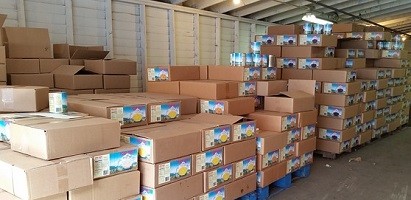
For example, if a producer of mattress producer decides to begin selling directly to the consumer, they must absorb the responsibilities previously taken on by the wholesaler, such as storage and transportation.
Some companies have responded by demonstrating that they are socially responsible. For example, Starbucks now offers fair trade coffee.
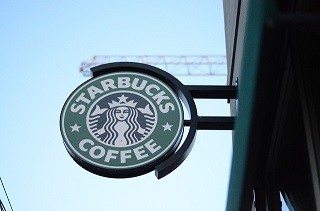
MODULE: 2
The main points from this module are as follows:
- The method of determining price can often be described using one of three models: cost-based pricing, competition-based pricing, customer-based pricing.
- MSRP stands for the manufacturer suggested retail price.
- Grid, or straight design, works best in retail environments where the customers shop the entire store, such as a supermarket.
- In a free-flow layout, merchandise is grouped in a free-flowing pattern, allowing customers to drift rather than walk up and down the aisles as in the grid layout.
- The exterior of a building is a customer’s first impression of a store.
- A marquee is a type of sign that projects out of a building.
- Banners are inexpensive but eye-catching and easy to change, as they are not permanent structures.
- Awnings are very useful in that they provide protection from the elements, reduce glare in windows, and prevent merchandise from fading in the sun.
- Good landscaping adds to the appearance of store.
- Window displays show a customer what types of good a store sells.
- When designing an interior display, the purpose is to show shoppers what they can buy.
- The primary principles of design are: balance, proportion, rhythm, emphasis, colour, lighting and harmony.
- A prop is something that is used to clarify the purpose or function of merchandise.
- Fixtures are how most merchandise is displayed. This can include movable shelves called gondolas, end-caps (shelving at the end of an aisle), or regular racks.
- Too much merchandise, too little merchandise, lack of a theme, poorly selected props, displays remained the same for too long, and lack of attention to detail
- Wholesaling refers to all activities required to market goods and services to business, institutions, or industrial users who hope to resell the goods.
Upon completion of this module, you will be able to:
- Define and describe the 4 P’s.
- Define product mixes, lines, and individual products.
- Explain the linear communication model.
- Describe the four important characteristics of communication tools.
- Explain the calculation for open-to-buy planning.
What is Retail Marketing
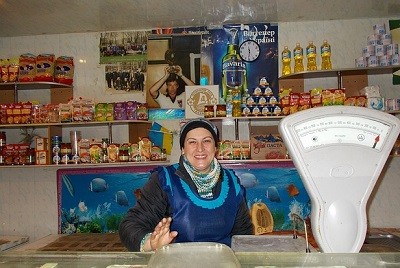
Just as types of retailers can vary drastically, so can retail management. Retailer managers may have to find products to buy and negotiate prices with suppliers. They may also have to organize distribution from supplier to shop.
Product refers to the decisions make on what goods and services are offered to a particular group. Companies must constantly revamp products to remain on-trend and up-to-date, deciding what it is that their customers need and want from their products.
Retailers must also decide what kind of assortment of their products that their customers require. This decision affects the retailer’s position in the marketplace, as different products appeal to different groups. Producers respond to needs for assortment through product mix, product lines, and products themselves.

Product lines refers to a group of products that are closely related but may appeal to people for different reasons. An example of this would be if a toothpaste brand offered several variations of tooth paste, such as a whitening formula, a sensitive formula, a child’s formula, etc.
And individual product refers to a distinct product, such as The Body Shop’s Vitamin E Eye Cream.
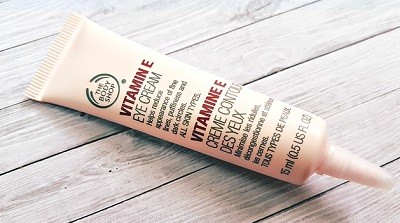
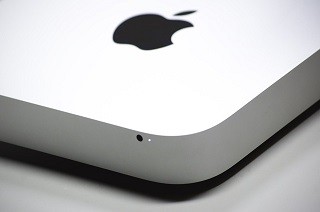
One strategy is to offer low-price versions of existing products to more price-conscious customers. For example, Apple launched the Mac Mini, which allows customers who previously couldn’t afford an “apple experience” to get a taste of the Mac experience.
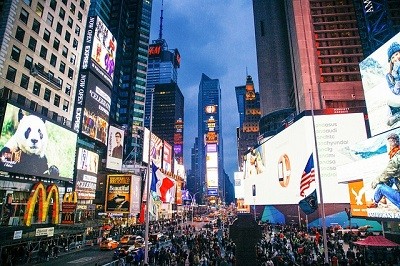
Marketing Communication in Retail
- The message
- The media
- The communication tools

But first, what is the basic model of communication?
Noise could include physical factors: coughing, traffic passing, telephone ringing, people talking in the background, etc. Or cognitive distractions such as complex language.
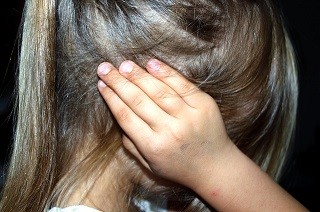
To rise above the noise, retailers must create a recognizable brand. Your brand is how consumers decide what they are going to buy.
Developing and communicating this brand should be done through a variety of communication tools, as each tool has a different set of characteristics that will affect audiences in different ways.
Four important characteristics of communication tools are communication potential, credibility, cost, and control.
Communication potential – communication potential focuses on the ability of the tool to deliver a personal message to the chosen audience and what level of interaction is offered.
For example, television ads are good for informing target audiences about key features of your product, whereas sales promotions are a call-to-action for audiences to make a purchase.
Credibility – how is this tool perceived by the target audience?
For example, PR campaigns might seem more credible than advertising campaigns.
Budgets must be decided upon and will influence what type of tool retailers can use.
Control – the ability to reach specific audiences and how flexible is the tool?
Is the message that target audiences receive the same as the message that the source intended to send?
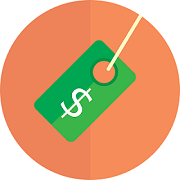
Merchandising and Assortment Planning
To support this task, there is open-to-buy planning. Open-to-buy planning requires that one knows how much inventory should be on-hand at the beginning of any given month and how much inventory needs to be received throughout the month to maintain the balance. This can be done through four simple steps:
- Plan for annual sales and markdowns.
- Plan for average stock, turn, and beginning of the month stocks.
- Calculate an open-to-buy plan to determine how much merchandise to receive each month. To do so, begin with the month stock plan and subtract sales, then subtract markdown dollars. The difference is how much merchandise the retailer should receive. Online calculators can be found to assist you in carrying out this formula.
- Adjust monthly and monitor sales, stock levels, and purchases.
To carry-out good assortment planning, a retailer must:
- Quickly address changes in customer demand and buying habits.
- Address competition.
- Manage inventory around customer needs.
The main points from this module are as follows:
- Retailers sell goods and services to individuals for them to consume.
- The retail marketing mix consists of four aspects: product, price, place, and promotion; sometimes this is called the four Ps.
- The linear communication model emphasizes that the message sender (source) use the right language and images (encoding) to create a message, which can be interpreted (decoded) by the message recipient (receiver). Successful messages must be heard over interruptions (noise).
- Four important characteristics of communication tools are: communication potential, credibility, cost, and control.
- Merchandise planning involves inventory management.
- Inventory management means maintaining an appropriate level of inventory or, in more simple terms: having the right amount of the right stuff at the right time.
- Assortment planning refers to the development of product attributes, styles, colors, and SKUs so that a retailer can address customer preference, demand, store space, and store characteristics.
Congratulations you have just Completed a Course of Retail Management - Merchandising, Distribution and Marketing
Let us know if you need a Certificate, But they will be an Assessment.
You will be assessed on the following Learning Outcomes: Define and describe ‘retail merchandising’; Explain how visual merchandising can affect sales; Outline the principles of design; Indicate how to design an effective display; Explain the channels of distribution; Define and describe the ‘4 Ps’; Discuss product mixes, lines and individual products; Describe the ‘linear communication’ model; Outline the four important characteristics of communication tools; Explain the calculation for ‘open-to-buy’ planning
Complete the Final Course Assessment & Become an C.C.U Graduate
- Score 80% or above to become an Alison Graduate and to claim your Certificate.
- You can retake the assessment as many times as you want.
Good Luck! 🍀
Call us to Start Your Assessment
